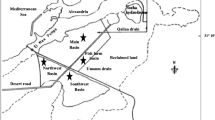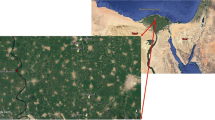Abstract
The concentrations of heavy metals in water, sediments, soil, roots, and shoots of five aquatic macrophytes species (Oenanthe sp., Juncus sp., Typha sp., Callitriche sp.1, and Callitriche sp.2) collected from a detention pond receiving stormwater runoff coming from a highway were measured to ascertain whether plants organs are characterized by differential accumulations and to evaluate the potential of the plant species as bioindicators of heavy metal pollution in urban stormwater runoff. Heavy metals considered for water and sediment analysis were Cd, Cr, Cu, Ni, Pb, Zn, and As. Heavy metals considered for plant and soil analysis were Cd, Ni, and Zn. The metal concentrations in water, sediments, plants, and corresponding soil showed that the studied site is contaminated by heavy metals, probably due to the road traffic. Results also showed that plant roots had higher metal content than aboveground tissues. The floating plants displayed higher metal accumulation than the three other rooted plants. Heavy metal concentrations measured in the organs of the rooted plants increased when metal concentrations measured in the soil increased. The highest metal bioconcentration factors (BCF) were obtained for cadmium and nickel accumulation by Typha sp. (BCF = 1.3 and 0.8, respectively) and zinc accumulation by Juncus sp. (BCF = 4.8). Our results underline the potential use of such plant species for heavy metal biomonitoring in water, sediments, and soil.





Similar content being viewed by others
References
Almeida, C. M. R., Mucha, A. P., & Vasconcelos, M. T. S. D. (2006). Comparison of the role of the sea club-rush Scirpus maritimus and the sea rush Juncus maritimus in terms of concentration, speciation and bioaccumulation of metals in the estuarine sediment. Environmental Pollution, 142(1), 151–159.
Almeida, C. M. R., Mucha, A. P., & Teresa Vasconcelos, M. (2011). Role of different salt marsh plants on metal retention in an urban estuary (Lima estuary, NW Portugal). Estuarine, Coastal and Shelf Science, 91(2), 243–249.
Barbosa, A. E., & Hvitved-Jacobsen, T. (1999). Highway runoff and potential for removal of heavy metals in an infiltration pond in Portugal. The Science of the Total Environment, 235(1–3), 151–159.
Bonanno, G. (2011). Trace element accumulation and distribution in the organs of Phragmites australis (common reed) and biomonitoring applications. Ecotoxicology and Environmental Safety, 74, 1057–1064.
Bonanno, G., & Giudice, R. L. (2010). Heavy metal bioaccumulation by the organs of Phragmites australis (common reed) and their potential use as contamination indicators. Ecological Indicators, 10(3), 639–645.
Bragato, C., Brix, H., & Malagoli, M. (2006). Accumulation of nutrients and heavy metals in Phragmites australis (cav.) trin. ex steudel and Bolboschoenus maritimus (L.) palla in a constructed wetland of the Venice lagoon watershed. Environmental Pollution, 144(3), 967–975.
Calzoni, G. L., Antognoni, F., Pari, E., Fonti, P., Gnes, A., & Speranza, A. (2007). Active biomonitoring of heavy metal pollution using Rosa rugosa plants. Environmental Pollution, 149(2), 239–245.
Camponelli, K. M., Lev, S. M., Snodgrass, J. W., Landa, E. R., & Casey, R. E. (2010). Chemical fractionation of Cu and Zn in stormwater, roadway dust and stormwater pond sediments. Environmental Pollution, 158(6), 2143–2149.
Chandra, R., Yadav, S., Bharagava, R. N., & Murthy, R. C. (2008). Bacterial pretreatment enhances removal of heavy metals during treatment of post-methanated distillery effluent by Typha angustata L. Journal of Environmental Management, 88(4), 1016–1024.
Clemens, S. (2006). Toxic metal accumulation, responses to exposure and mechanisms of tolerance in plants. Biochimie, 88(11), 1707–1719.
Davis, B., & Birch, G. (2010). Comparison of heavy metal loads in stormwater runoff from major and minor urban roads using pollutant yield rating curves. Environmental Pollution, 158(8), 2541–2545.
Demirezen, D., & Aksoy, A. (2006). Common hydrophytes as bioindicators of iron and manganese pollutions. Ecological Indicators, 6(2), 388–393.
Deng, H., Ye, Z. H., & Wong, M. H. (2004). Accumulation of lead, zinc, copper and cadmium by 12 wetland plant species thriving in metal-contaminated sites in china. Environmental Pollution, 132(1), 29–40.
Deng, H., Ye, Z. H., & Wong, M. H. (2006). Lead and zinc accumulation and tolerance in population of six wetland plants. Environmental Pollution, 141(1), 69–80.
Directive 2008/105/EC (2008) Directive 2008/105/EC of the European Parliament and of the Council of 16 December 2008 on environmental quality standards in the field of water policy, amending and subsequently repealing Council Directives 82/176/EEC, 83/513/EEC, 84/156/EEC, 84/491/EEC, 86/280/EEC and amending Directive 2000/60/EC of the European Parliament and of the Council.
Directive 86/278/EEC (1986) Directive 86/278/EEC of the Council of 12 June 1986 on the protection of the environment, and in particular of the soil, when sewage sludge is used in agriculture.
Directive 98/69/EC (1998) Directive 98/69/EC of the European Parliament and the Council of 13 October 1998 relating to measures to be taken against air pollution by emissions from motor vehicles and amending Council Directive 70/220/EEC.
Directive 98/70/EC (1998) Directive 98/70/EC of the European Parliament and the Council of 13 October 1998 relating to the quality of petrol and diesel fuels and amending Council Directive 93/12/EEC.
Fritioff, Å., & Greger, M. (2006). Uptake and distribution of Zn, Cu, Cd, and Pb in an aquatic plant Potamogeton natans. Chemosphere, 63(2), 220–227.
Hares, R. J., & Ward, N. I. (1999). Comparison of the heavy metal content of motorway stormwater following discharge into wet biofiltration and dry detention ponds along the London orbital (M25) motorway. The Science of the Total Environment, 235(1–3), 169–178.
Hébrard-Labit, C. (2006). Recommandations pratiques pour la gestion des produits de l’assainissement pluvial. Guide technique Labo. Paris: Ponts et Chaussées.
Karlsson, K., Viklander, M., Scholes, L., & Revitt, M. (2010). Heavy metal concentrations and toxicity in water and sediment from stormwater ponds and sedimentation tanks. Journal of Hazardous Materials, 178(1–3), 612–618.
Kiem, S. (2002). Heavy metal pollution of water from road runoff. Bachelor degree thesis, School of Engineering, James Cooks University.
Legret, M., & Pagotto, C. (1999). Evaluation of pollutant loadings in the runoff waters from a major rural highway. The Science of the Total Environment, 235(1–3), 143–150.
Lesage, E., Rousseau, D. P. L., Meers, E., Tack, F. M. G., & De Pauw, N. (2007). Accumulation of metals in a horizontal subsurface flow constructed wetland treating domestic wastewater in Flanders, Belgium. Science of the Total Environment, 380(1–3), 102–115.
Leung, C., & Jiao, J. J. (2006). Heavy metal and trace element distributions in groundwater in natural slopes and highly urbanized spaces in mid-levels area, Hong-Kong. Water Research, 40(4), 753–767.
Maddison, M., Soosaar, K., Lohmus, K., & Mander, Ü. (2005). Cattail populations in wastewater treatment wetlands in Estonia: biomass production, retention of nutrients and heavy metals in phytomass. Journal of Environmental Science and Health. Part A, Toxic/Hazardous Substances & Environmental Engineering, 40(6–7), 1157–1166.
Makepeace, D. K., Smith, D. W., & Starley, S. J. (1995). Urban stormwater quality: Summary of contaminant data. Critical Review in Environmental Science and Technology, 25(2), 93–139.
Mangani, A., Berloni, F., Bellucci, F., Tatano, & Maione, M. (2005). Evaluation of the pollutant content in road runoff first flush waters. Water, Air, and Soil Pollution, 160(1–4), 213–228.
Mark, A., & Marek, P. E. (2009). Hydraulic design manual. Design Division (DES), Texas Department of Transportation: Austin.
Markert, B. (2007). Definitions and principles for bioindication and biomonitoring of trace metals in the environment. Journal of Trace Elements in Medicine and Biology, 21(S1), 77–82.
Mays, P. A., & Edwards, G. S. (2001). Comparison of heavy metal accumulation in a natural wetland and constructed wetlands receiving acid mine drainage. Ecological Engineering, 16(4), 487–500.
Mishra, V. K., & Tripathi, B. D. (2008). Concurrent removal and accumulation of heavy metals by the three aquatic macrophytes. Bioresource Technology, 99(15), 7091–7097.
Mishra, V. K., & Tripathi, B. D. (2009). Accumulation of chromium and zinc from aqueous solutions using water hyacinth (Eichhornia crassipes). Journal of Hazardous Materials, 164(2–3), 1059–1063.
Mishra, V. K., Upadhay, A. R., Pandey, S. K., & Tripathi, B. D. (2008). Concentrations of heavy metals and aquatic macrophytes of Govind Ballabh Pant Sagar and anthropogenic lake affected by coal mining effluent. Environmental Monitoring and Assessment, 141(1–3), 49–58.
Murakami, M., Nakajima, F., & Furumai, H. (2008). The sorption of heavy metal species by sediments in soakaways receiving urban road runoff. Chemosphere, 70(11), 2099–2109.
Nabulo, G., Oriem-Origa, H., & Diamond, M. (2006). Assessment of lead, cadmium and zinc contamination of roadside soils, surface films and vegetables, in Kampala City, Uganda. Environmental Research, 101(1), 42–52.
Norme NF EN ISO 15586 (2004). Qualité de l’eau: dosage des éléments traces par spectrométrie d’absorption atomique en four graphite—Annexe B: Digestion des échantillons de sédiments, Norme européenne, mai 2004.
Norme NF X31-147 (1996). Qualité des sols—Sols, sédiments—Mise en solution totale par attaque acide, juillet 1996.
Raskin, I., & Ensley, B. D. (2000). Phytoremediation of toxic metals: Using plants to clean up the environment. New York: Wiley.
Sansalone, J. J., & Buchberger, S. G. (1997). Partitioning and first flush of metals in urban roadway storm water. Journal of Environmental Engineering, 123(2), 134–143.
Sansalone, J. J., & Kim, J.-Y. (2008). Suspended particle destabilization in retained urban stormwater as a function of coagulant dosage and redox conditions. Water Research, 42(4–5), 902–922.
Sasmaz, A., Obek, E., & Hasar, H. (2008). The accumulation of heavy metals in Typha latifolia L. grown in a stream carrying secondary effluent. Ecological Engineering, 33(3–4), 278–284.
Sengupta, A. K. (2002). Environmental separation of heavy metals: Engineering processes. Boca Raton: Lewis.
Smith, R. M., & Martell, A. E. (1976). Critical stability constants. New York: Plenum.
Verbruggen, N., Hermans, C., & Schat, H. (2009). Mechanisms to cope with arsenic or cadmium excess in plants. Current Opinion in Plant Biology, 12(3), 364–372.
Yousef, Y. A., Wanielista, M. P., Hvitved-Jacobsen, T., & Harper, H. H. (1984). Fate of heavy metals in stormwater runoff from highway bridges. Science of the Total Environment, 33(1–4), 233–244.
Zechmeister, H. G., Hagendorfer, H., Hohenwallner, D., Hanus-Illnar, A., & Kiss, A. (2006). Analyses of platinum group elements in mosses as indicators of road traffic emissions in Austria. Atmospheric Environment, 40(40), 7720–7732.
Zhou, Q., Zhang, J., Fu, J., Shi, J., & Jiang, G. (2008). Biomonitoring: An appealing tool for assessment of metal pollution in the aquatic ecosystem. Analytica Chimica Acta, 606(2), 35–50.
Acknowledgments
This work was conducted within the regional and cooperative Pollution des Eaux et des Sols en milieu Urbain (POLESUR) project, co-funded by the region of Pays de Loire (France). The authors want to thank the Cofiroute society, a motorway concession operator in the northwest of France, to have given them access to the study site.
Author information
Authors and Affiliations
Corresponding author
Rights and permissions
About this article
Cite this article
Ladislas, S., El-Mufleh, A., Gérente, C. et al. Potential of Aquatic Macrophytes as Bioindicators of Heavy Metal Pollution in Urban Stormwater Runoff. Water Air Soil Pollut 223, 877–888 (2012). https://doi.org/10.1007/s11270-011-0909-3
Received:
Accepted:
Published:
Issue Date:
DOI: https://doi.org/10.1007/s11270-011-0909-3




